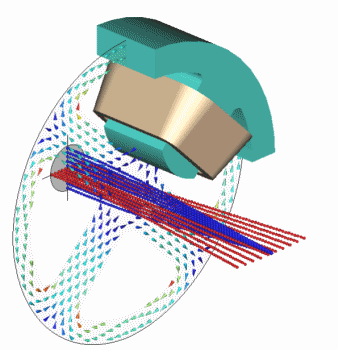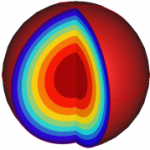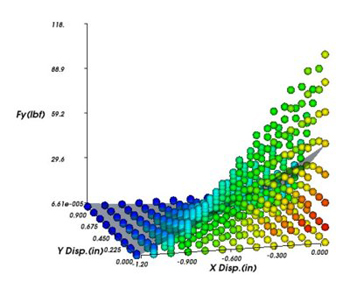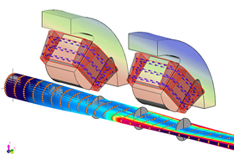White Papers
Vacuum Feedthrough Device Designed with AMPERES
The goal of this study is to design a magnetic feedthrough that will be used to transmit torque to mechanisms in vacuum chambers. It is typically not desirable to place motors directly in the vacuum space, due to outgassing and cleanliness requirements of semiconductor processing. The outgassing of motor varnishes and adhesives creates contamination that can adversely affect the vacuum processes. These types of devices are also used to transmit torque from dry to wet environments as can be seen from the multitude of pump mechanisms currently available in the market.

Electromagnetic Sensor Design: Key considerations when selecting CAE Software
Even though sensors based on electromagnetic principles often appear to be simple devices, they can pose challenging analysis problems. This paper will provide guidelines to aid in the proper selection and application of electromagnetic CAE software for simulating and optimizing sensor systems. Example electric, magnetic and eddy current simulations will be used for illustration. In particular, this paper will discuss the approximations and simplifications that are often required to produce practical engineering models.

Accuracy Analysis of Charged Particle Trajectory CAE Software
Though there exists extensive literature on the subject of charged particle beam analysis, most often only the simplest of geometries can be treated analytically. Advances in numerical solutions of both ordinary and partial differential equations have led to the development of Computer Aided Engineering (CAE) software packages that permit the simulation of more complex systems that include “real world” deviations that inevitably occur.
Since accuracy of simulation results is fundamental for the selection of beam analysis software, this paper will use that criterion to examine the most popular numerical methods and illustrate techniques for evaluating their suitability.

Simulation of Coupled Electromagnetic/Thermal Systems using CAE Software
Electromagnetic induction heating occurs in electrically conducting materials when they are present in time varying magnetic fields. This phenomenon is utilized in a wide range of industrial applications.
This paper will illustrate examples of coupled electromagnetic/thermal field simulations for both steady-state and transient conditions.

Joint white paper with Tecplot, Inc: “Optimizing an Electromechanical Device with Multidimensional Analysis Software”
Modern CAE software allows engineers to investigate a multitude of design variations that could not possibly be considered using conventional physical prototypes.
In this paper we will first illustrate parametric methods for automatically creating virtual prototypes of electromechanical actuators (in our case simple electromagnetic solenoids) using the AMPERES and MAGNETO programs from INTEGRATED Engineering Software. We will then use a specific case study to show how the Tecplot Chorus program can assist in determining optimal design choices.

Automated Design Testing Procedures using Software Simulation Tools
Even though sensors based on electromagnetic principles often appear to be simple devices, they can pose challenging analysis problems. This paper will provide guidelines to aid in the proper selection and application of electromagnetic CAE software for simulating and optimizing sensor systems. Example electric, magnetic and eddy current simulations will be used for illustration. In particular, this paper will discuss the approximations and simplifications that are often required to produce practical engineering models.

Beam Spot Size as a Function of Excitation Levels of Magnetic Quadrupoles
This paper will present an overview of the focusing properties of magnetic quadrupoles and show how beam spot size can be visualized using arc segment emitters. We will also show how parametric variation of the excitation current can be used to determine the optimum level for minimum spot size at points along the beam axis. Some other concepts discussed in this white paper:
- Rays launching from the perimeter of an emitter surface provide a fast efficient method of computing spot size.
- Parametric variation of magnet excitation to determine the optimal level for obtaining minimum spot size at points along the beam axis.

Efficient Simulation of Electric Line Parameters for Cables
This paper is based on some of the research done to determine good default solver setup for CABLES – a new program created from parts of ELECTRO and OERSTED. The goal was to provide a minimalistic interface dedicated to solving electrical parameters in sector cables. This paper is a case study for efficiently assessing the accuracy of the results for a specific four sector cable and sheath, and adjusting the solver conditions as necessary. The discussion focusses on how to effectively use options commonly available in FEM and related software to determine efficient and trusted protocols for analyzing models of a given type.
